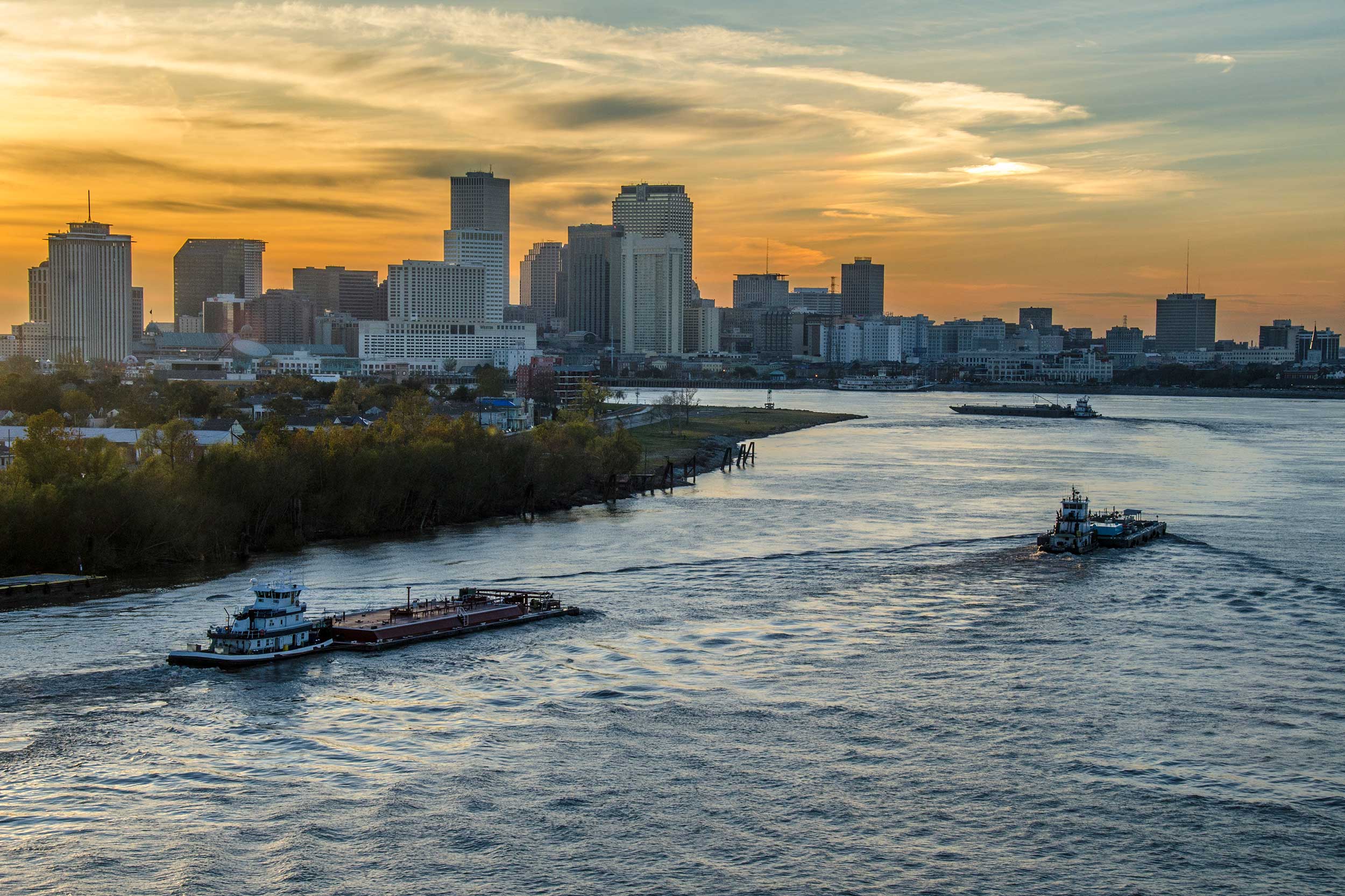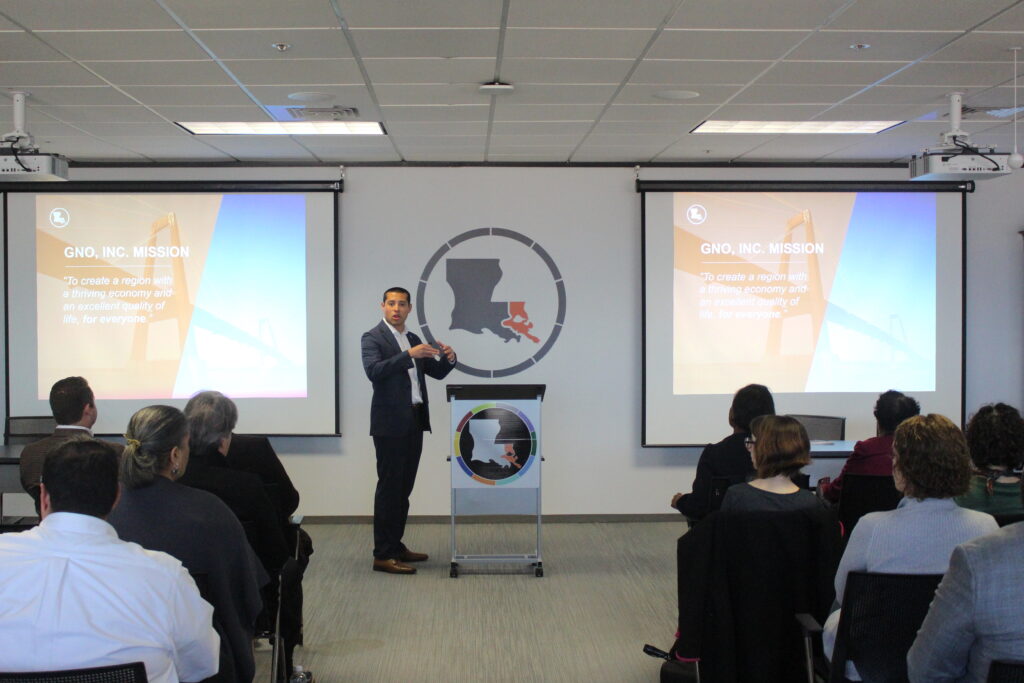
Infrastructure Week: Stressing link between coastal restoration and jobs
Showing off Louisiana’s rapidly-expanding coastal restoration program with an aerial view, representatives of Greater New Orleans Inc., the U.S. Chamber of Commerce and several national environmental groups stressed the job link between those projects and the state’s economy.
From the window of a Southern Seaplane, the views provided to reporters and photographers as part of a two-day Infrastructure Week program in New Orleans included of the area’s now-completed hurricane risk reduction levee system, including views of the West Closure Complex and the Lake Borgne surge barrier.
But the real focus of the tour was on locations where coastal restoration projects are either planned, under way or just completed. With the state likely to be spending more than $500 million a year on restoration projects over the next 15 years, thanks to money the state will receive from legal settlements involving the BP oil spill, and other money it expects to receive for future hurricane and flooding protection projects, both industry and environmental groups say the potential for job growth is significant.
And the work also is important for protecting the state’s existing economic assets, including a variety of petrochemical and other industrial facilities, they said.
“If we’re not protecting these communities through coastal protection, through coastal rebuilding efforts, we’re going to lose a lot of our critical economic assets and we’re going to lose our economic competitiveness as well,” said Lacy McManus, director of program development for Greater New Orleans Inc.
“We recognize that we have a unique opportunity to build a huge specialized workforce and industry base of firms, of practitioners, of individuals with unique skill sets really able to tackle our land loss issues and our erosion issues,” she said.
And the development of that job pool will make the state uniquely positioned to export its expertise both nationally and internationally, even rivaling the Dutch in providing assistance for restoration and water resource projects elsewhere, she said.
McManus said there already are 30,000 people in what she describes as water management positions, many of whom actually see themselves as focusing on infrastructure.
Indeed, the term used by McManus and environmental activists in discussing coastal restoration projects is “green infrastructure,” designed to both stress the importance of rebuilding wetlands to help reduce storm surge, and to elevate these projects in the eyes of national politicians working on President Donald Trump’s proposal to dramatically increase infrastructure investments across the nation.
McManus said one key feature for the jobs created by these projects is that they will require a variety of education levels, including individuals with high school, junior college, technical school and college-level degrees.
Some of better-paying technical positions include welders, pipefitters, crane operators and engineering technicians, she said.
Much of the aerial tour focused on the coastal restoration features, including:
- A proposal to restore wetlands and cypress trees in the Central Wetlands Unit adjacent to the Lower 9th Ward in New Orleans and the Arabi neighborhood of St. Bernard Parish.
- A potential location on the east bank of the Mississippi River in Plaquemines Parish where the state has proposed building a Mid-Breton Sediment Diversion,
which could move up to 35,000 cubic feet per second of water from the river into Breton Sound in an effort to maintain existing wetlands and build new wetlands in open water. - The potential West Bank location of the proposed Mid-Barataria Sediment Diversion near Myrtle Grove in Plaquemines Parish, which would redirect up to 75,000 cubic feet per second of water and sediment into upper Barataria Bay, again to nourish and rebuild wetlands. Steve Cochran, vice president of the Environmental Defense fund and director of Restore the Mississippi River Delta, said when the diversion is turned on during high-river periods, it would be the equivalent of the seventh or eighth largest river in the United States.
- The now-complete Lake Hermitage Marsh Creation project on the West Bank, which has created or restored nearly 700 acres of marsh and 6,000 linear feet of shoreline on the eastern rim of the lake. The wetlands were built with sediment mined from the Mississippi pumped through a pipeline to open water areas in the Barataria Basin.
- The Bayou Dupont Marsh and Ridge Restoration project, which has already created or nourished 1,000 acres of marsh and added 1,000 linear feet of ridge on the West Bank in Plaquemines and Jefferson parishes, also built using Mississippi sediment and a pipeline.
The plane also flew over the Caernarvon Freshwater Diversion, which has been operating since 1991. Visible from the plane was evidence that wetlands now cover about half of Big Mar, a failed 2,000-acre square agriculture area created in the early 1900s that had been open water. From the air, it also was clear that wetlands south and east of the diversion’s outfall area remain distressed after being damaged by saltwater intrusion and wave action during Hurricane Katrina in 2005.
Brownish sediment-rich water also was visible through much the Bohemia Spillway area along the east bank of the river in Plaquemines Parish, the result of the flow of freshwater through a crevasse in the levee dubbed Mardi Gras Pass. While the Lake Pontchartrain Basin Foundation and other environmental groups have urged the gap to remain open, Plaquemines Parish has requested a permit from the Army Corps of Engineers to fill it in, citing, in part, complaints about the effects of freshwater on fisheries.
To read the full article click here.


